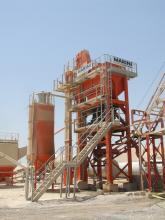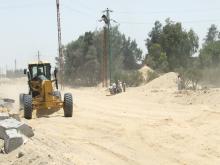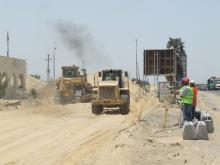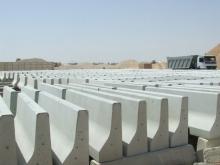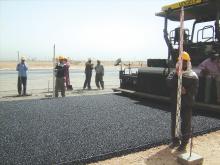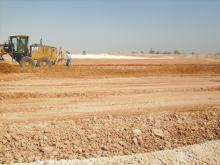A huge highway upgrade project will transform the Cairo-Alexandria road link into a world-class connection as Mike Woof reports. The work to upgrade the Desert Highway connecting Egypt's sprawling capital Cairo with its major port Alexandria, is one of the country's largest infrastructure projects for many years. This 220km highway link is being widened and improved to cope with the hugely increased traffic volumes resulting partly from Egypt's fast growing vehicle population. The Egyptian economy is strong
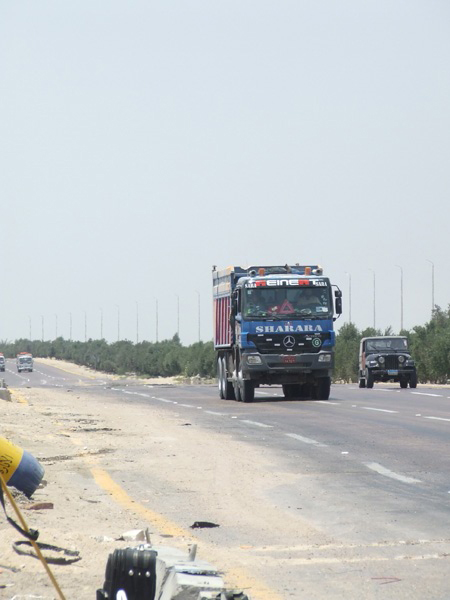
Construction work is taking place alongside live traffic on the existing route
A huge highway upgrade project will transform the Cairo-Alexandria road link into a world-class connection as Mike Woof reports
The work to upgrade the Desert Highway connecting Egypt's sprawling capital Cairo with its major port Alexandria, is one of the country's largest infrastructure projects for many years. This 220km highway link is being widened and improved to cope with the hugely increased traffic volumes resulting partly from Egypt's fast growing vehicle population. The Egyptian economy is strong at present while the country's population is also increasing fast and the existing highway connection between Cairo and Alexandria is struggling to cope, despite having been widened several times over the years.The increasing traffic volumes are not limited solely to Egyptian vehicles either. The port of Alexandria provides an important gateway for goods being brought both to and from the region, as well as being a pivotal point for transport into the country and its neighbours. Upgrading this vital road connection and turning it into a tolled route is of importance not only for Egypt, but for its neighbours also, with Libya to the west, Sudan to the south and Israel, Jordan, Palestine and South Arabia in the east. With work progressing well on the new 5,600km North Africa highway running all the way from Morocco, through Algeria and connecting Tunisia and Libya with Egypt, the need for an upgraded Cairo-Alexandria connection is even more acute. Vehicle traffic will be able to flow more easily between North Africa and the Middle East, hugely benefiting trade and transport and Egypt is the crossroad.
Although the work involves upgrading and improving the existing Cairo-Alexandria highway, the extra width required by the new road layout along the 220km length of the route means that a substantial earthmoving project has had to be carried out. The design of the new highway features four lanes running in both directions while there are also twin lane service roads the length of either side of the main highway. Because the project is so large, it has been split into five sections, with large Egyptian firms such as
The new link will vastly improve road safety, with radar being used to monitor speed and ensure that traffic does not exceed the limits of 100km/h and 120km/h in various sections. Weighing stations are being installed at the toll areas and heavy trucks that exceed the allowable weight limits will be directed along the service roads running alongside the main highway. This will significantly reduce wear and tear on the surface of the highway and extends its life, while periodic maintenance and repairs to the service roads will cause less disruption to the overall traffic flow. The move will also ensure greater safety by separating the slower moving heavy trucks from the faster passenger cars, light commercial vehicles and buses on the main highway.
Meanwhile to reduce the risk of high speed crossover accidents, the main highway features substantial New Jersey-type barriers on both sides. These are being installed beside both carriageways along the entire length of the highway, with barriers also along the outside of the route. Different construction methods are being used to build these centre-line barriers and one contractor is using pre-cast units made at a facility next to its site office. One of the other contractors is bringing in pre-cast sections made elsewhere, while yet another of the contractors is running a
Orascom
Akram Farrag Iskander is deputy project manager for Orascom's section of the Cairo-Alexandria highway improvement project and he said, "The purpose of the upgrade is to raise the quality and safety of the road and services."Hossam Mounir is in charge of equipment procurement at Orascom and added, "Before the road was very dangerous at night because it was dark and narrow in places. The main problem of these roads is with the heavy trucks but the new highway will be for cars and buses only."
Work on the project commenced in 2008 and Orascom started operations on its section in 2009. Orascom is one of the largest contractors in Egypt and its 34km stretch of the Cairo-Alexandria highway upgrade is from kilometre 127 to kilometre 161 and is worth some US$120 million. This work includes major and minor crossings of the main highway, with both bridges and tunnels being built.
Iskander said, "All the project should be finished by mid 2011."
The majority of the earthmoving portion of the project is being carried out using graders and dozers, a technique devised in Egypt to allow fast and efficient construction in the country's largely sandy soils. Compared with a European or North American road construction site, the absence of excavators is immediately apparent but the widespread use of graders and dozers is consistent with the country's ground conditions. Orascom is using some of its
Equipment plays a key role in the project and Orascom invests heavily in ensuring its fleet is up to date. The firm has 56 graders in its fleet, of which 37 are new Caterpillar 14M models and the remainder are either Caterpillar's earlier 14H or 160H models. The company also has around 50 dozers, most of which are Caterpillar D9s although there are also three older D10s in the fleet. Orascom's section of the Cairo-Alexandria highway upgrade project is using 15 of the firm's Cat graders (11 of them new 14Ms) as well as four of the D9s. The company regularly updates its equipment and Mounir added, "We have 1,200 items of large machinery and 70% of our fleet is less than three years old."
The Caterpillar machines have been supplied by Egyptian dealer
The highway features a compacted earth/stone base comprising two structural layers of 150mm, to make a total of 300mm of earth and aggregate that has been graded and compacted to a very tight quality specification. After the 14M graders make the finish cut, the soil compactors are brought in and they deliver a compaction specification of 98% in seven passes. The performance is ensured through the use of compaction meters on the machines.
Once the earthmoving and compaction of the base is complete, the paving work can commence. Due to Egypt's high ambient temperatures during daytime the mix design has been carefully selected to help minimise rutting, which can be a major problem on some of the country's older roads. However the low temperatures of night time have also had to be factored into the specification of the asphalt used. With Egypt's low rainfall levels, considerations over wet weather skid resistance have been less of an issue during the road design and specification.
Orascom has 12 pavers in the fleet, with several new Vogele Super 1800-2s, two old
The firm's new Vögele Super 1800-2 pavers being used for the main highway are set with screed widths of 4.6m for this project and Orascom has had its operators trained with the new machines by the manufacturer. In all these machines pave some 21,000m2/day on the project. The asphalt surface has a compaction specification of 98% and the main highway features a 50mm wearing course that is laid on top of a 60mm binder course with a 70mm base course over the compacted earth base. The main highway is expected to last 12-15 years before requiring resurfacing. The service roads are being built with a similar compacted earth/stone base but with two asphalt layers, one of 50mm on top of the other of 60mm, reflecting the lower traffic volumes and vehicle speeds they will have to cope with. With this design, the service roads are expected to last 8-10 years before requiring resurfacing. At the junctions of the service roads and the entrances to the bridges, the same triple layer asphalt specifications will be used as on the main highway however. The asphalt is produced on-site and Mounir said, "We have four Marini UltiMAP batching plants and they can each deliver 120tonnes/hour."
The company has sited the batching plants along the route of the Cairo-Alexandria road to produce the different asphalt grades for the wearing course, binder course and base course. Marini commissioned the UltiMAP plants on-site for Orascom and also produced the first batches to ensure that the output met the necessary specifications. The paved sections are also tested to ensure the specifications are met and Orascom has a well-equipped lab on-site featuring a wide range of the latest equipment to check quality on a continuous basis.
Although asphalt is being used to surface the highway, concrete is also being used widely throughout the project and most notably for the bridges, off-ramps and safety barriers. Orascom's site has a concrete batching plant that is used to produce the pre-cast barrier and light pole base sections. The well organised pre-casting facility is able to produce up to 120/day of the 960mm high, 1.5tonne centre-line barrier sections and around 24/day of the light pole bases.
The original plan was to produce the concrete sections off-site but Iskander said, "We started with the moulds and we made them here. We can do them cheaper than anyone else and to a better quality as well."
The firm has 120 moulds at its on-site casting facility and each section is left for 20 hours to cure properly. The concrete pouring is carried out at night and quality is crucial. Iskander said, "The most important thing is the cleaning of the moulds."
The sections are handled using a tower crane as well as telehandler and a small mobile crane, which also move the pre-cast base sections for the light poles being installed on the project. Installing the light poles is no small task in itself with Orascom's 34km section requiring 4,300 in all. Iskander added, "At the main road the light poles are 12m high and at the service road they are 10m high."
The concrete base for these barrier sections is poured on the compacted earth/stone base for the road and Iskander said, "A benefit of the pre-cast method is that you can install them before or after the asphalt. It's a very clean process."
Where asphalt surfacing is carried out after installation of the pre-cast sections, Orascom places plastic sheeting over the New Jersey type barrier to keep it clean and he added, "...and we install around 120/day."
Orascom's section of the project includes installing lighting for the main road, building the service roads and also carrying out the necessary drainage and irrigation work. Another part of the project involved demolition work to remove buildings and bridges that lie in the path of the new service roads, although Orascom carried out only a small portion of the work, which was largely tackled by specialist contractors. Other tasks include installing pipes under the main highway and the firm has a micro-tunnelling machine for this work.
The Arab Contractors
Osama Shawky is vice chairman of The Arab Contractors, the part state-owned firm which is building the section of the highway close to Cairo as well as two other stretches of the road. He explained that the previous link had two, three or four lanes in either direction at various locations and this has resulted in serious congestion in places. However with four lanes in either direction along its entire length as well as the continuous service roads, there will be fewer high congestion points along the new highway. And he said, "This will increase the safety of the road."The firm's three sections of the Cairo-Alexandria highway are each around 25km long and are worth a total of some $300 million. The Arab Contractors is upgrading 13 intersections along the route, forming a major component of its work on the highway project. These will include the slip ramps to connect the main highway to the parallel service roads as well as the bridges or tunnels taking traffic from one side to the other of the route.
The intersection between the Cairo-Alexandria highway and The 6th October Bridge is a major project in itself. This connects one of the city's busiest roads to the new highway, as well as linking the new business park and industrial area situated close by with Cairo. However, the highway project involves the construction of several new bridges, the construction of which forms a major part of the work for The Arab Contractors.
The layout of the new Cairo-Alexandria highway, with a main centre section featuring four lanes in either direction as well as twin service roads at either side, is of particular note as it is highly innovative. Another novel feature of the layout is that there are no direct crossovers off the main highway back onto itself. To change direction, a driver takes an off-ramp onto the service roads and these connect with all the junctions along the route. There are junctions from the main highway to the service roads spaced at distances of 5km apart.
The thinking behind this design is that the high speed traffic will flow in an uninterrupted fashion on the main highway while the multiple junctions are on the lower speed service roads, with an overall benefit to user safety. It is worth noting that this concept is akin to the multiple exit system seen on the German autobahn network, with users taking off-ramps from the main highway and then driving along a parallel road that provide a choice of exits onto other routes. Shawky said, "All local traffic will use the service roads. To cross the highway you use the service road and a crossover bridge."
Innovative construction methods are being introduced by the firm for this project and Shawky said, "The ramp construction is using a new method called reinforced earth."
These feature blocks combined with reinforced earth, offering a system of construction that is easy and quick to build yet meets the requirements of the project for a durable and long-lasting structure.
The company also invests heavily in new machines and is using Caterpillar 14M graders for the earthmoving work, again supplied by Egyptian dealer Mantrac. Accuracy is ensured with these machines by the use of laser levelling techniques, with total stations placed every 200-300m.
The structure of the road is being upgraded considerably while the alignment is also being improved. The design speed of the original highway was considerably lower than the average speed of vehicles currently using it and road user safety was a consideration in increasing the design speed to 120km/h. Shawky said, "We started work by milling out the existing surface so as to prepare the surface for the new road."
The Arab Contractors is employing a surfacing technique that is being used for the first time in Egypt. To maximise surface quality the firm is using echelon paving and is using material transfer vehicles, in this instance Vögele MT1000-1 units, to ensure a constant supply of asphalt. The company saw this equipment being used on a project in Morocco and realised that it could also be employed in Egypt with its similar climate and conditions.
Once it is fully open to traffic, the new Cairo-Alexandria highway will be tolled, with up-to-date, automatic toll tag technology to collect fees from users. And this new route will offer considerable safety gains over the previous highway connection, with its severe congestion.

